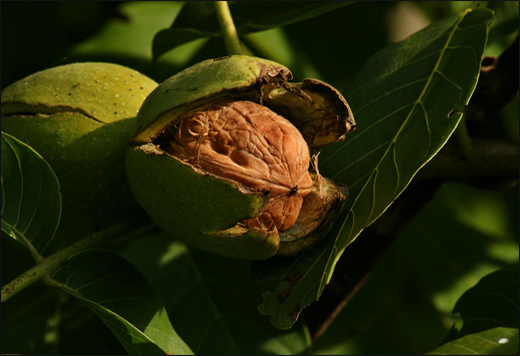Walnut/ Juglans regia Linn. – Ayurvedic Properties, Practical Uses & Medicine
Abstract
Juglans regia Linn., commonly known as the walnut tree, is a valuable medicinal plant used extensively in traditional medicine systems, including Ayurveda. Renowned for its nutritional and therapeutic benefits, the plant parts, such as the nuts, leaves and bark, are utilised to treat various ailments. This article explores the botanical classification, Ayurvedic synonyms, vernacular names, habitat, morphology, therapeutic properties, systemic actions, chemical constituents, home remedies, parts used, dosage and concludes with its significance in natural health care.

Introduction
Walnut (Juglans regia), known as Akrot in many Indian languages, is a valued Ayurvedic fruit renowned for its medicinal properties. Traditionally, it has been used to treat various skin conditions and other inflammatory skin disorders. Its natural healing and antimicrobial properties make it effective in promoting faster recovery and preventing infections. Besides its topical applications, walnut is also recognised for its ability to enhance physical strength and overall vitality, thanks to its rich nutritional profile, including essential fatty acids, vitamins and minerals. Additionally, walnuts support brain health and improve cognitive function, making them a holistic remedy for both body and mind in Ayurvedic practice.
Scientific Classification
- Kingdom – Plantae
- Clade – Angiosperms
- Order – Fagales
- Family – Juglandaceae
- Genus – Juglans
- Species – Juglans regia Linn.
Synonyms
- Vrintaphala – The fruit is round in shape
- Swadu Majja, Gudashraya – The fruit is enclosed in a shell and resembles jaggery in both shape and colour; sweet in taste
- Shailasambhava
- Pilu
- Karparala
- Akshoda
- Keereshta
- Pruthucchada
Vernacular Names
- Hindi names – Akrot, Akroot, Akhrot
- English name – Walnut
- Kannada name – Akrotu
- Tamil name – Akrottu
- Bengali – Akhrot
- Gujarati – Akhrot
- Telugu – Akhiru
- Marathi – Akhrot
- Malayalam – Akroti
Habitat
Juglans regia is native to the temperate regions of Central Asia and is extensively cultivated in parts of Europe, North America and the Indian subcontinent. It prefers well-drained, fertile soils and moderate climates with distinct seasonal changes. The tree thrives in mountainous or hilly areas and requires adequate moisture but not waterlogging. It is commonly found in orchards, botanical gardens and as a shade tree in various regions worldwide.
Morphology
The walnut tree (Juglans regia) is originally native to Iran and is now widely cultivated across the Himalayan regions of India, including Kashmir, Himachal Pradesh and the northeastern states. It is a large deciduous tree that can grow between 40 to 130 feet tall. The leaves are pinnately compound, typically arranged alternately on the twigs and consist of 5 to 25 serrated or toothed leaflets. The tree bears separate male and female flowers, making it monoecious. Botanically, the walnut is the seed of a drupe, not a true nut. As the fruit matures, the outer husk becomes brittle and separates, revealing the hard, wrinkled shell of the walnut inside, which typically splits into two halves and is commonly seen in commercial markets.
Varieties
There is another variety of the Walnut which is as follows:
It is a jungle nut which is found in Assam and especially in the south. It is Aleurites moluccana Willd. (Fam. Euphorbiaceae). Its fruits are oval-shaped, 5 cm in diameter and inside which two seeds like walnuts emerge. It contains oil, which is a laxative. The seeds are roasted and eaten, which has some laxative properties. They should not be eaten without roasting because they contain a poisonous element which gets destroyed by roasting. The seeds are made into wicks and burnt, due to which it is also called ‘The Candle-nut Tree’.
Classical Categorisation
- According to Bhavprakash Nighantu – Amradi Phala Varga
- According to Dhanvantari Nighantu – Amradi Varga
- According to Raj Nighantu – Amradi Varga
Ancient Verses
अक्षोटकोपि वातादसदृशः कफपित्तकृत् ॥
(Bhavprakash Nighantu Amradi Phala varga 129)
According to the above shloka, Walnuts have the same properties as almonds. Walnuts increase Pitta and Kapha dosha.
Ayurvedic Properties
- Taste (Rasa) – Sweet (Madhur)
- Physical property (Guna) – Heavy (Guru), Unctuous (Snigdha)
- Potency (Veerya) – Hot Potency (Usna)
- Post-digestion effect (Vipaka) – Sweet (Madhur)
- Effect on tridosha – Balance Vata dosha
Therapeutic Properties
- Pushtikaraka – Rich in nutrients and promotes nourishment
- Balya – Enhances strength and boosts immunity
- Snigdha – Oily and unctuous in nature
- Ushna – Has a heating effect on the body
- Guru – Heavy and slow to digest
- Brumhana – Nourishing and body-building in action
- Antioxidant
- Anti-inflammatory
- Antimicrobial
- Astringent
- Laxative
- Tonic for the nervous system
- Blood purifier
- Skin healing properties
Systemic Actions
- Nervous System: Supports brain health and cognitive functions
- Digestive System: Improves digestion and relieves constipation
- Skin: Heals wounds, eczema, and other dermatological conditions
- Respiratory System: Helps alleviate cough and bronchial issues
- Circulatory System: Improves blood circulation and reduces cholesterol
- Immune System: Enhances immunity through antioxidant action
Chemical Composition
- Terpenoid substances
- Eugenol
- Geranic acid
- Alpha-pinene
- Beta-pinene
- Limonene
- Beta-eudesmol
- Juglone
- Bis-juglone
- Oligomeric juglones
- 15.5% protein
- 11% carbohydrates
- 2% mineral matter
- Vitamin A
- Vitamin B
- Ascorbic acid (Vitamin C)
- Tellimagrandin I
- Tellimagrandin II
- Casuarictin
Modern Overview
Antimicrobial Activities
Juglone, a key compound found in walnuts, is widely used in pharmaceuticals for its potent antimicrobial properties. Walnut leaf extract, known for its strong antioxidant effects, has been shown to inhibit the growth of Bacillus cereus. Additionally, it is effective against several bacteria responsible for gastrointestinal infections in humans. The husks of the walnut also demonstrate inhibitory effects on the growth of various pathogenic bacterial strains.
Antidiabetic Activities
Polyphenolic compounds found in walnuts, including Tellimagrandin II, Casuarictin, and Tellimagrandin I, have demonstrated strong inhibitory activity against several digestive enzymes such as glycosidase, maltase, sucrase, and amylase.
Dermatological Activities
Ellagic acid, a key component in the leaf extract of Juglans regia, has been found to be effective in treating skin pigmentation and reducing pores. The ethanolic extract of walnut leaves shows promising potential as a natural skin-whitening agent, making it a valuable addition to cosmetic and dermatological formulations.
Anticancer Activities
Juglone has been shown to inhibit intestinal carcinogenesis in rats and functions as a chemopreventive agent in human intestinal neoplasia. It also exhibits strong cytotoxic effects in vitro against various human tumour cell lines, including HCT-15 (colon carcinoma), HL-60R (doxorubicin-resistant leukaemia), and HL-60 (leukaemia) cells. Recent studies have also demonstrated Juglone’s ability to inhibit the growth of the SGC-7901 cell line, derived from metastatic gastric adenocarcinoma, and to induce apoptosis in sarcoma in vivo.
Practical Uses
- Roasted walnuts are consumed regularly to enhance physical strength and are beneficial for individuals experiencing general debility or muscle weakness.
- The powdered bark of the walnut tree is combined with ghee or butter and applied to areas affected by herpes and burning sensations.
- A decoction made from walnut leaves is administered in doses of 30–40 ml to help treat skin disorders such as scabies and ringworm.
- A bark decoction of Akshotaka is used in 30–40 ml doses as a remedy for intestinal worm infestations.
- For wound care, a paste prepared from the bark of the walnut tree is applied topically to fresh wounds to promote healing.
- Decoction of walnut bark is also used for gargling to manage conditions like gingivitis and dental caries.
- Walnuts are commonly used in global cuisines as both a flavour enhancer and a rich nutritional ingredient in various dishes.
Part Used
- Fruit
- Leaf
- Bark
Dosage
- Powder – 2-3 gm
- Decoction – 40-50 ml
- Fruit – 10-20 gm
Ayurvedic Medicines
- Balamritam
- Amritprash Ghrita
Planet Ayurveda Medicines
- Go-Richh Hair Conditioner
- Green Tea algae aloe vera gel scrub
- Rose Almond Honey Natural Face Polisher
Conclusion
Juglans regia Linn. is a versatile plant with extensive applications in both nutrition and medicine. Its rich chemical composition lends it powerful antioxidant, anti-inflammatory and antimicrobial effects. Widely used in Ayurveda and other traditional medicine systems, it offers therapeutic benefits across multiple body systems, including the nervous, digestive and integumentary systems. With continued research and sustainable cultivation, walnut remains a vital natural resource for health and wellness worldwide.



